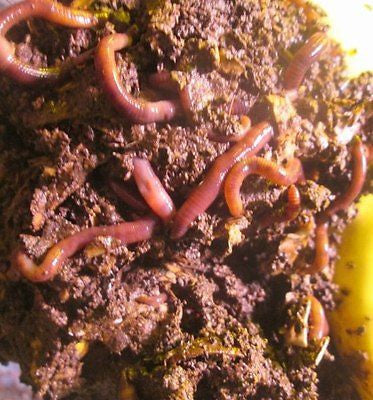Popular red worms: Tips for raising them
Popular red worms: Tips for raising them
Blog Article
Making Use Of Red Wigglers for Reliable Organic Waste Disposal
Using red wigglers for organic garbage disposal offers a compelling technique to managing food scraps while advertising ecological sustainability. These worms not just improve waste decay yet additionally produce beneficial worm spreadings, which can substantially boost dirt wellness. Their capability to refine big quantities of natural product with marginal effort settings them as an accessible solution for houses and neighborhoods alike. Nonetheless, understanding the subtleties of establishing up an effective worm bin and preserving an optimum environment is essential for maximizing their benefits. The following action in this procedure might surprise you.
Benefits of Using Red Wigglers
One of the most compelling advantages of utilizing red wigglers for natural garbage disposal is their remarkable efficiency in composting. These worms, clinically understood as Eisenia fetida, are particularly adjusted for damaging down natural products, allowing them to refine waste as much as two times their body weight every day. This fast decomposition not just increases the composting procedure but also creates nutrient-rich worm spreadings that substantially enhance soil high quality.
Furthermore, red wigglers add to a decrease in landfill waste. By drawing away natural products from garbage dumps, they assist reduce methane discharges-- a potent greenhouse gas. This environmental benefit is important in the fight against environment adjustment.
Additionally, red wigglers are low-maintenance and can flourish in different environments, making them available for both beginner and experienced composters. Their capacity to duplicate promptly makes sure a consistent population, facilitating recurring waste handling.
Setting Up Your Worm Container
Developing an efficient worm container is vital for making the most of the advantages of composting with red wigglers. Guarantee the container has sufficient drainage holes to protect against excess moisture, as red wigglers grow in a damp however not soaked environment.
(red wigglers)Following, prepare the bed linens product, which functions as the worms' environment and food source. Shredded newspaper, cardboard, and coconut coir are exceptional alternatives. Go for a bed linens deepness of about 4 to 6 inches. The bin should be positioned in a dark, temperature-controlled location, preferably in between 55 ° F and 77 ° F, to preserve worm activity.
Once the container is established up, introduce the red wigglers, allowing them to accommodate to their brand-new atmosphere. It's essential to keep track of moisture degrees and temperature frequently. A well-kept container will certainly not only sustain the wellness of the worms however also promote effective decomposition of natural waste. By complying with these standards, you can develop a flourishing ecosystem that adds to sustainable waste monitoring.
(red worms for sale)
What to Feed Red Wigglers
An understanding of the ideal diet regimen for red wigglers is essential for maintaining a healthy and balanced worm populace and maximizing composting effectiveness. Red wigglers thrive on a diverse diet that mainly contains organic products. Perfect food resources consist of veggie scraps, fruit peels, coffee premises, eggshells, and shredded paper. These products not only offer vital nutrients however also contribute to the moisture equilibrium within the worm container.
It is essential to avoid particular foods that can hurt the worm population. Red wigglers should not be fed meat, milk products, oily foods, or processed things, as these can draw in insects and develop unpleasant smells. red wigglers. Furthermore, citrus fruits and spicy foods need to be lessened, as their acidity can be destructive to worms
Keeping track of the worm container for food consumption rates will certainly aid guarantee that red wigglers are obtaining an adequate diet plan while preserving an efficient composting atmosphere. Proper this article feeding practices are crucial for promoting a growing community within the worm bin.
Preserving Your Worm Habitat
A well-kept worm environment is crucial for the health and efficiency of red wigglers. To make certain optimal conditions, it is important to keep an eye on temperature level, dampness, and aeration within the worm bin. Red wigglers prosper in a temperature level series of 55 to 77 levels Fahrenheit. Exceeding this variety can worry the worms, so it's essential to put the container in an appropriate area far from straight sunshine and severe temperature levels.
An excellent regulation of thumb is to preserve moisture at approximately 70% to 80%. If the bed linens ends up being as well wet, it can lead to anaerobic problems that are damaging to the worms.

Making Use Of Worm Spreadings in Horticulture
Rich in nutrients and advantageous bacteria, worm castings act as an exceptional organic fertilizer for horticulture. Produced through the gastrointestinal processes of red wigglers, these castings consist of an array of necessary nutrients, consisting of nitrogen, phosphorus, and potassium, which advertise durable plant development. Unlike artificial fertilizers, worm castings provide a slow-release system, making certain that nutrients are available to plants over a prolonged duration, consequently minimizing the danger of nutrient leaching and soil exhaustion.
Along with nutrition material, worm spreadings improve soil framework and aeration, improving wetness retention and drainage. The microbial life existing in worm castings helps to reduce pathogens and advertises a healthy dirt community, further profiting plant health. When included into the dirt or utilized as a leading dressing, worm spreadings can significantly improve seed germination rates, origin development, and total plant vigor.
For optimum results, garden enthusiasts ought to use worm spreadings at a rate of 1-2 inches per square foot, mixing them right into the soil or including them into potting blends. Overall, using worm spreadings is an environmentally friendly strategy to enhancing dirt fertility and guaranteeing growing garden atmospheres.
Final Thought

Report this page